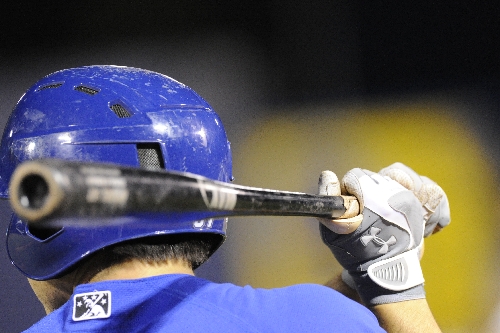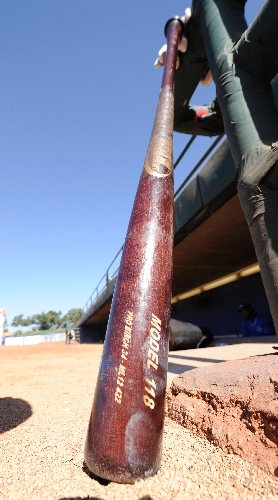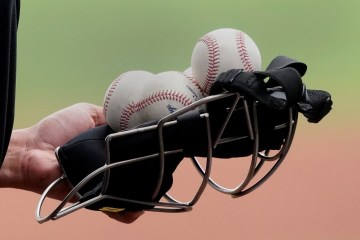Batters’ tools of trade continue to evolve
In the classic baseball film "The Natural," Robert Redford's mythical character, Roy Hobbs, performed astonishing feats with "Wonderboy," a magical bat made out of a tree that was struck by lightning.
Baseball legend "Shoeless" Joe Jackson named several of his bats - including "Blond Betsy," "Ol' Genril" and "Big Jim" - but his favorite was "Black Betsy," which, incredibly, survived his entire 13-year big league career.
These days, a player is lucky if a bat lasts a month before it's broken.
"There's no telling. I could go out there tonight and break three or I could not break any for a while," 51s center fielder Anthony Gose said. "Last year I went through nine bats."
With bats breaking so often, it's virtually impossible for a player to cultivate a favorite.
"It's whichever one feels comfortable that day," 51s catcher Travis d'Arnaud said. "Some years I've used 10, some 30. I've broken four or five this year."
Wood bats have evolved in other ways as well since the Louisville Slugger was born in 1884 - growing from a few heavyweight hickory and white ash models crafted by a couple of companies to hundreds of lightweight white ash and maple models made by more than 30 firms approved by Major League Baseball.
Babe Ruth reportedly began his hitting career using a 54-ounce hickory bat made by Hillerich & Bradsby - which created the Louisville Slugger - and didn't use anything lighter than a 40-ounce bat until late in his career.
Likewise, Jackson's Black Betsy was a 48-ounce bat made of hickory and darkened with tobacco juice.
"That's when guys threw 75 (mph)," 51s left fielder Eric Thames said. "Now guys throw so hard you've got to get that (bat) around. There's no way anyone could use that now.
"Everyone goes pretty much light because guys have good cutters and sinkers, and you've got to get that (bat) head out."
While Ty Cobb and Joe DiMaggio used 42-ounce bats, Ted Williams, Hank Aaron and other Hall of Famers used bats ranging from 31 to 33 ounces - a trend firmly entrenched today, when most players use 34-inch bats weighing 31 or 32 ounces.
"You talk to old-school guys, and they could use 38-ounce bats because the pitch was one speed," Las Vegas hitting coach Chad Mottola said. "Now you have a split-finger (fastball) coming at 90 (mph), a fastball coming at 100 and a curveball at 78.
"Once you're committed to swing a 40-ounce bat, you're committed. That's kind of gone out of the game just because it's impossible to stop that heavy a bat."
At 35 inches, 35 ounces, Cubs outfielder Alfonso Soriano and Rangers outfielder Josh Hamilton are believed to wield the biggest bats in the big leagues.
While hickory ultimately proved to be too heavy, white ash was the most popular wood used for bats until 2001, when Barry Bonds ignited a maple bat craze by using a 32-ounce "Sam Bat" made of maple to mash a single-season record 73 home runs.
"I always use maple just because maple will last longer and ash will flake and break easier than maple," Thames said. "Maple bats are harder, a little bit heavier and more dense. Ash is grainier."
Maple bats have been controversial because of the frequency and manner in which they break, often sending shattered shards of wood soaring dangerously onto the field of play.
"When they break, it's like a sword or sharp object reaching the field, whereas an ash kind of breaks in your hand," Mottola said.
MLB addressed the issue in 2010, when it banned bats made of ultra-light maple and reduced the maximum diameter of the barrel to 2.61 inches from 2.75 - which was the standard for more than 100 years.
While Louisville Slugger continues to be the most popular brand used by big leaguers, a bevy of other companies also pitch bats to players - who are provided with a dozen each spring in big league camp and can receive more from sponsors or agents or buy them themselves.
51s pitcher Robert Coello, who was called up to the Toronto Blue Jays on Friday, has opened his own company, Carrera Sports International, which has provided bats this season for Miguel Cabrera, Omar Vizquel and Marlon Byrd, to name a few.
"We've sent a bunch of samples out to different guys," Coello said. "There's a lot of competition."
D'Arnaud uses Max Bats, Gose uses Marucci, and Las Vegas slugger Adam Lind uses Old Hickory.
While there doesn't appear to be another "Wonderboy" or "Black Betsy" on the horizon, some players still manage to make a bat last for nearly an entire season.
"Lind, when we played together, had the 'Wonderboy' bat," Mottola said.
Playing for Triple-A Syracuse and Toronto in 2006, Lind said he used the same bat during spring training and every day in batting practice until late in the year.
"It ended up breaking on me with a week left in the season," he said.
While it's unclear if - like Hobbs in "The Natural" - Lind replaced it with the "Savoy Special," he does have a clear philosophy about bats.
"Some, you don't like how they feel so you don't ever use them, some break right away, some don't have any hits in them so you don't use them, and one has a lot of hits and you use that for two or three weeks," he said.
While former Philadelphia Phillies slugger Richie Ashburn slept with his bat when he was on a hot streak and Seattle Mariners star Ichiro Suzuki keeps his bat in a silver case, Gose isn't a superstitious bat man.
"Either you're going to get a hit or you're not," he said. "It has nothing to do with the bat."
Contact reporter Todd Dewey at tdewey@reviewjournal.com or 702-383-0354.
LAS VEGAS -- 9
COLORADO SPRINGS -- 3
KEY: Adeiny Hechavarria had three hits and three RBIs to back winner Bill Murphy, who held the Sky Sox to one earned run and three hits in five innings.
NEXT: Sky Sox (RHP Tyler Chatwood) at 51s (RHP Yohan Pino), 12:05 p.m. today, KBAD-AM (920)



















